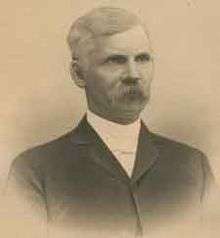Bennett H. Young

Bennett Henderson Young (1843–1919) was a Confederate officer who led forces in the St Albans raid (October 19, 1864), a military action during the American Civil War. As a lieutenant of the Confederate States Army, he entered Vermont from Canada and occupied the town of St. Albans.
Early life


Young was born in Nicholasville, Kentucky; his birthplace is now on the National Register of Historic Places. He was 18 years old when he enlisted as a private in the Confederate 8th Kentucky Cavalry, a unit that became a part of General John Hunt Morgan's cavalry command.
The St. Albans Raid
Young had been captured in John Hunt Morgan's 1863 raid in Ohio, but escaped to Canada in the fall of that year. Young went to the south via Nova Scotia and Bermuda, where he proposed Canada-based raids on the Union as a means of building the Confederate treasury and forcing the Union army to protect their northern border as a diversion. Young was commissioned as a lieutenant and returned to Canada, where he recruited other escaped rebels to participate in the October 19, 1864 raid on St. Albans, Vermont, a quiet town 15 miles (25 km) from the Canada–US border.
Young and two others checked into a local hotel on October 10, saying that they had come from St. John's in Canada for a "sporting vacation." Every day, two or three more young men arrived. By October 19, there were 21 cavalrymen assembled; just before 3:00 p.m. the group simultaneously staged an armed robbery of the three banks in St. Albans. They announced that they were Confederate soldiers and stole a total of $208,000. As the banks were being robbed, eight or nine of the Confederates held the townspeople prisoner on the village green as their horses were stolen. One townsperson was killed and another wounded. Young ordered his troops to burn the town down, but the four-ounce bottles of Greek fire they had brought failed to work, and only one shed was destroyed.
The raiders fled with the money into Canada, where they were arrested by authorities and held in Montreal. There, the Lincoln administration retained prominent Irish-Canadian lawyer Bernard Devlin, QC, as counsel for the prosecution in the subsequent court case, which sought the raiders' extradition. The court ultimately decided that the soldiers were under military orders and that the officially neutral Canada could not extradite them to America. They were freed, but the $88,000 the raiders had on them was returned to Vermont.
Later career
After the end of the Civil War, Young was excluded from President Andrew Johnson's amnesty proclamation. He could not return home until 1868. Thus, he spent time studying law and literature in Ireland and at the University of Edinburgh. After being permitted to return to the United States, he became a prominent attorney in Louisville, Kentucky. His philanthropic works were legion. Young founded the first orphanage for blacks in Louisville, a school for the blind, and did much pro bono work for the poor. He also worked as a railroad officer as President of the Louisville Southern Railroad, author, and National Commander of the United Confederate Veterans.
Notes
The still standing railroad bridge over the Kentucky River at Tyrone, Kentucky was named Young's High Bridge for him and Youngstown, Kentucky was also named for him.
External links
- Bennett H. Young
- The St. Albans raid
- St. Albans Raid: Spies, Raiders and Partisans
- "Bennett H. Young". Find a Grave. Retrieved 2008-02-14.
- McAfee, John J. (1886). Kentucky politicians : sketches of representative Corncrackers and other miscellany. Louisville, Kentucky: Press of the Courier-Journal job printing company. pp. 176–180.
